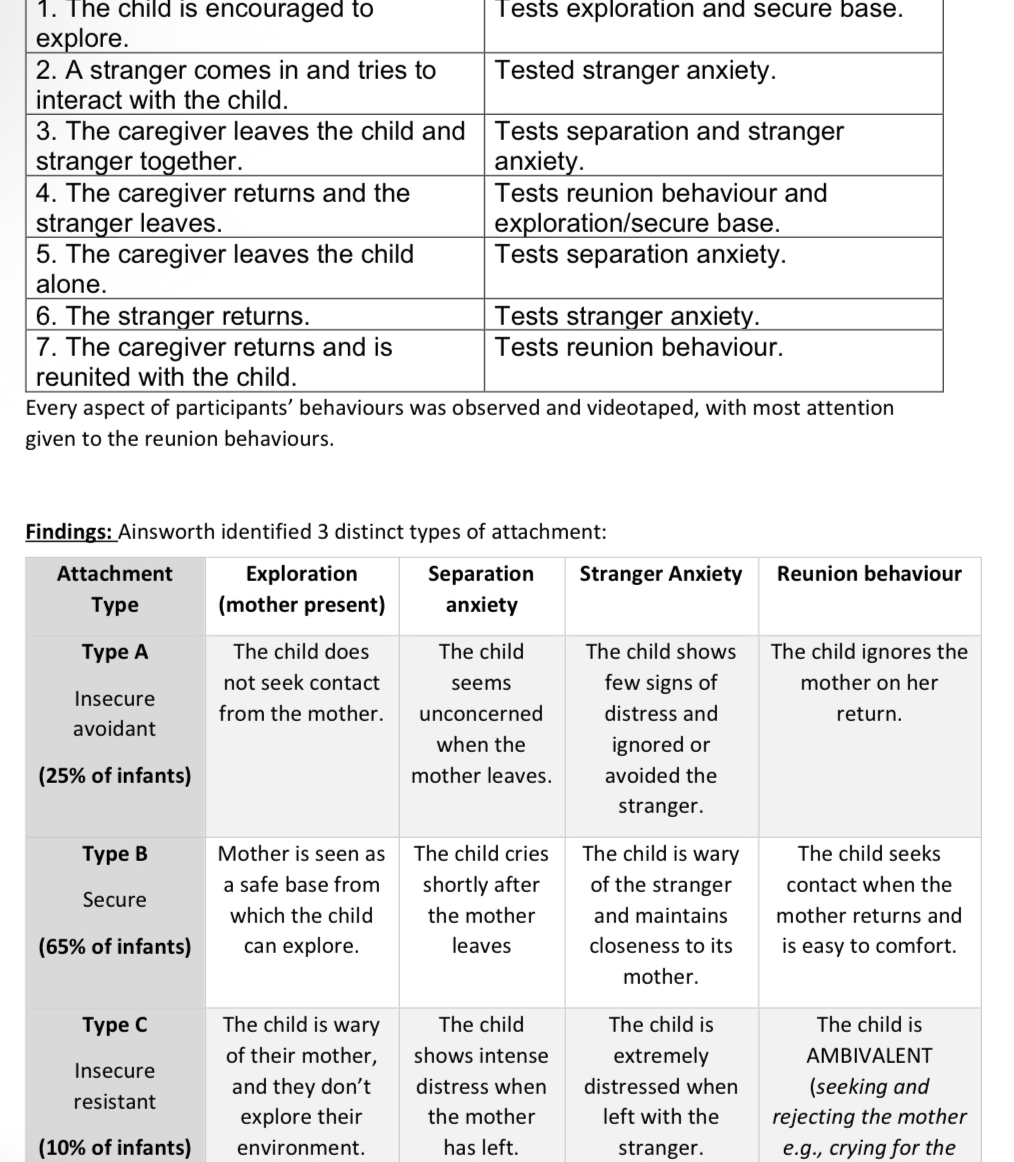Psychology essay 14
Describe and evaluate Ainsworth’s work on attachment. As part of your evaluation, you should refer to the work of at least one other researcher
Knowledge (A01) Ainsworth’s ‘Strange Situation’ and Types of Attachment
The Strange Situation was a technique devised by Mary Ainsworth to study attachment behaviours.
Procedure: The study took place in an unfamiliar room with one way glass, so the behaviour of the infants could be observed covertly.
Infants were aged between 12 and 18 months. The sample comprised of 100 middle-class American families.
The behaviour used to judge the attachment included:
Proximity seeking: an infant with a secure attachment will stay fairly close to the caregiver.
Exploration: a secure attachment enables a child to feel confident to explore the room, using the caregiver as a secure base.
Separation anxiety: does the child protest when separated from the caregiver?
Stranger anxiety: if the attachment is secure, you would expect the child to display anxiety when approached by a stranger.
Reunion Response: this measures how the child reacts when finally reunited with the caregiver.

Evaluation (A03) Ainsworth’s ‘Strange Situation’ and Types of Attachment
✓ Reliable measure: P-One strength is that the Strange Situation is a reliable measure of attachment; it takes place under controlled conditions and the behavioural categories are easy to observe. E-Bick (2012) looked at the inter-rater reliability in a team of trained Strange Situation observers and found agreement on attachment type of 94% of tested babies. L- This means we can be confident that the attachment type of an infant identified in the Strange Situation does not just depend on who is observing them.
✓ Lacks ecological validity: P-One issue is that critics argue the findings are inaccurate as the Strange Situation is an unrealistic situation for both the infant and caregiver. E-Some researchers suggests attachment types tend to be stronger in this controlled setting rather than in the child’s own home. E-E.g., they may cry less when in a familiar environment. L-This reduces the ecological validity of the procedure and limits its applicability.
✓ Culturally biased: P-Another issue of the Strange Situation is based on American attachment behaviours and ignores how child rearing practices in other cultures may affect behaviour in the strange situation. E-For example, Japanese infants are rarely separated from their parents, E-therefore, this can result in the child being wrongly classified as being insecure resistant. L-This reduces the external validity of the procedure and limits its applicability.
✓ Good predictive validity: P-One strength of the Strange Situation is that its outcome predicts a number of aspects of the baby’s later development. E-A large body of research has shown that babies and toddlers assessed as Type B (secure) tend to have better outcomes than others, both in later childhood and in adulthood. E-In childhood this includes better achievement in school and less involvement in bullying (McCornick et al 2016, Kokkinos 2007).Securely attached babies, also tend to go on to have better mental health in adulthood (Ward et al. 2006) L-This suggests that the Strange Situation measures something real and meaningful in a baby’s development.
At least one other researcher
Mary Ainsworth developed the Strange situation, which was a study that took place in an unfamiliar observed room with infants of 100 middle class families ages 12-18 months. The procedure has seven episodes, each lasting three minutes. The first one where the child is encouraged to explore, the second when a stranger comes in and tries to interact with the child, the third where the caregiver leaves, the fourth where the caregiver returns and the stranger leaves, the fifth when the caregiver leaves the child alone, the sixth when the stranger returns and the seventh when the caregiver returns and is reunited with the child. These tested proximity seeking, exploration, separation anxiety, stranger anxiety and reunion response.
Ainsworth identified three distinct types of attachment- insecure resistant, secure and insecure avoidant. Insecure resistant is an attachment type characterised by the failure to acknowledge the presence of the mother or stranger but intense distress when left alone. Secure is attachment is an attachment type whereby the infant explores freely, using the mother as a safe base. Insecure avoidant is an attachment type characterised by distress when left by the mother but mixed emotions upon her return.
One strength of the strange situation is that it is a reliable measure of attachment as it takes place under controlled conditions and the behavioural categories are easy to observe. Bick 2012 looked at the inter-rater reliability and found agreement on attachment type of 94% of tested babies. This means we can be confident that the attachment type of an infant identified in the strange situation does not just depend on who is observing them.
One weakness of the strange situation is that the study lacks ecological validity. The strange situation is an unrealistic situation for both the infant and caregiver. Some researches suggests attachment types tend to be stronger in this controlled setting rather than in the child’s own home, for example they may cry less in a familiar environment. This reduces the ecological validity of the procedure and limits its applicability.
Another weakness of the strange situation is that it is based on American attachment behaviours and ignores how child rearing practices in other cultures may affect behaviour in the strange situation. For example Japanese infants are rarely separated from their parents, which can lead to the child being wrongly classifies as insecure resistant. This reduces the external validity of the procedure and limits its applicability.